Best NVIDIA Graphics Cards in 2023

[ad_1]
When deciding on parts for a new rig, the graphics card is now the most integral component of a gaming PC, given that it is the key driver of gaming-centric performance on a PC. Processors, memory, and storage do have a say in the overall cost of a PC, but they are often overshadowed by the cost of the accompanying GPU in the system.
A key decision that gamers must make when it comes to a modern gaming PC is whether they want to go with AMD or Nvidia as the de facto gaming partner on their rig. Nvidia leads on the software front thanks to more refined tech such as DLSS 3.0, better ray tracing support, and better hardware encoders on the new RTX 4000 series GPUs. However, some users go for AMD as they feel it offers better value thanks to more aggressive pricing from Team Red for its own offerings.
For gamers who simply wish to experience the best possible visual fidelity or need the highest frame rates possible, Nvidia simply can’t be beaten thanks to its mammoth RTX 4000 series offerings at the top end. The RTX 4090 is a pricey but extremely premium offering that has no equivalent from competing AMD hardware (and Intel, to a lesser extent). If one is, however, more cash-strapped or wishes to get a more middle-of-the-road solution for gaming, there are options for gamers on a budget as well.
How To: Picking The Best Nvidia GPU For Your Needs
Picking the best Nvidia GPU for an end user is a mix of price considerations, performance requirements, and target resolutions as well as considering the importance of the latest AI sharpening techniques such as DLSS that currently dominate discussions between enthusiasts as Nvidia insists that Moore’s Law is dead. This means that any prospective buyer needs to do their research to ensure they end up with a product that both meets their needs and remains relevant for the foreseeable future.
This means that the search can quite easily center around the following requirements:
Price: As modern GPUs continue to trudge upwards in terms of pricing, it does help to have a price ceiling in mind when looking for a gaming or productivity-related purchase. As with most PC components, diminishing returns kick in when it comes to price-to-performance ratios as one moves up higher, making it a great idea to budget around a GPU purchase in 2023 as higher-end models clock well north of $1500.
Performance: While modern GPUs use plenty of techniques including AI sharpening via DLSS/FSR/XESS to bridge the gap for current generation titles, it does help in most cases to have a higher-end or faster GPU under the hood simply because of how important rasterization performance can be even before other optimizations kick in for various titles.
It does help to know what raw computing power is available to the end user as GPUs are used for a variety of tasks apart from gaming and misleading nomenclature based on upscaling and sharpening tech that has resulted in a fragmented performance market with current-gen GPUs – in some cases having sometimes worse-than-expected performance gains in certain games and benchmarks despite being more recent releases.
VRAM/Memory: As games and render workloads continue to edge higher in terms of memory requirements and users continue to get higher resolution displays, the amount of VRAM available to a current or last generation GPU directly affects performance and can be a bottleneck and higher resolutions or with newer, more demanding titles, making VRAM on offer an increasingly important specification to track for end-users.
Generational DLSS Support: Nvidia’s AI sharpening tech, DLSS has evolved considerably over the last few years and unlike its competition, is exclusive to its RTX series GPUs where it makes use of its Tensor Cores to deliver on its promise of higher performance. The latest version of DLSS (DLSS3/3.5) brings considerable performance enhancements but performs significantly better on the new RTX 4000 (Ada Lovelace) based GPUs which are custom-designed from the ground up to deliver much better performance out of the box in DLSS3 or higher titles than last-generation Nvidia GPUs.
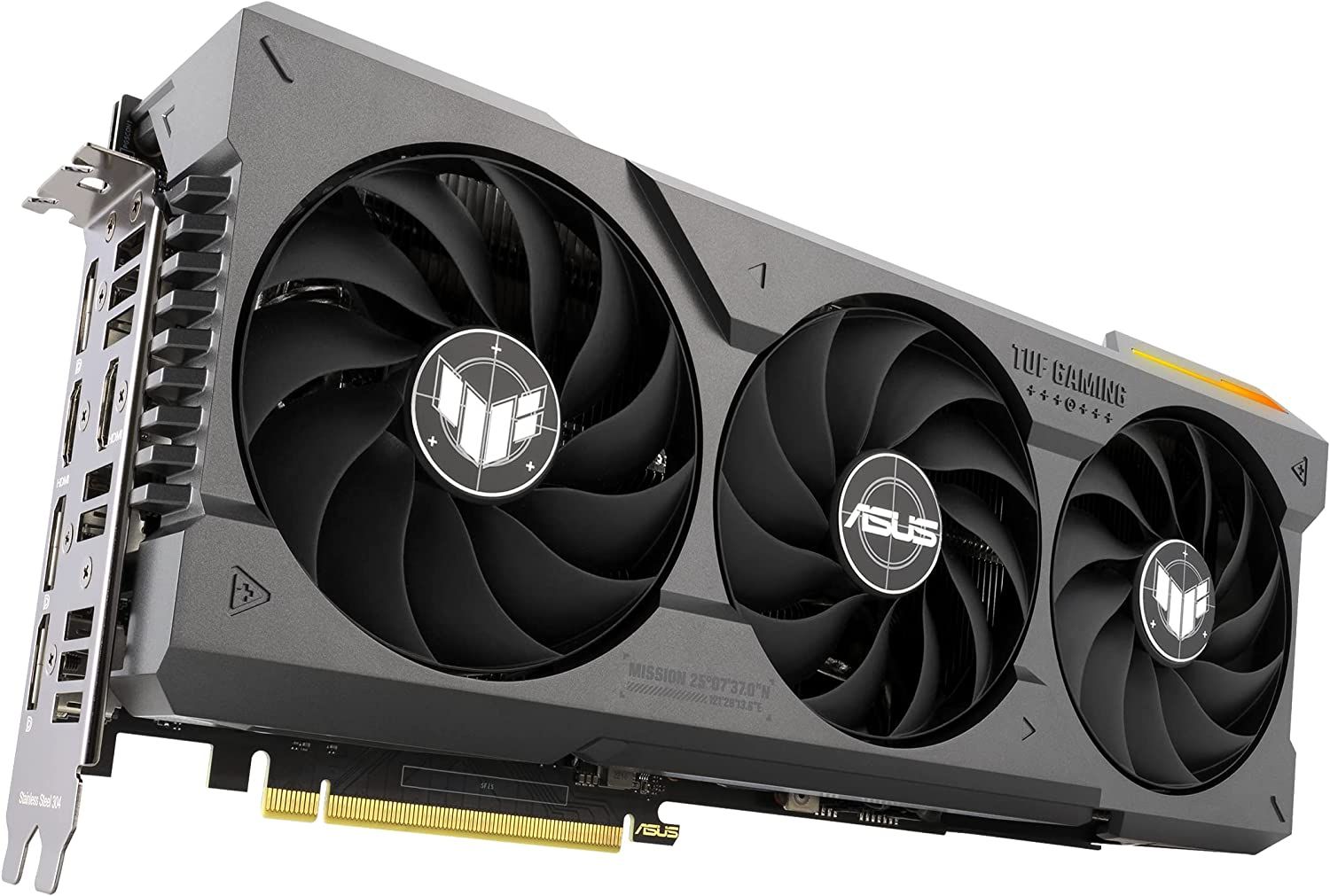
ASUS TUF Gaming NVIDIA GeForce RTX™ 4070 Ti OC Edition
The Best Overall Nvidia Graphics Card
A TUF Deal To Ignore
The Asus TUF RTX 4070TI is a silent but top-tier performer that builds on the TUF lineup’s advantages while trading at a minor premium from Nvidia’s stock Founders Edition that brings no-nonsense overclocking to a very capable vapor chamber to maintain tight thermal control over excellent performance.
- Brand
- ASUS
- Cooling Method
- Vapor Chamber
- GPU Speed
- 2310 Mhz
- Interface
- PCI-E 4.0
- Memory
- 12GB GDDR6
- Power
- 285W
- Boost Speed
- 2760 MHz (OC) 2730 MHz (Default)
- UserBenchmark Ranking
- 4th
- CUDA Cores
- 7680
- Excellent performance that offers top-tier rasterization in line with the RTX 3090TI
- Offers excellent DLSS 3.0 and ray tracing performance out of the box
- Efficient gaming performance with relatively low power draw
- Powerful cooling keeps temperatures relatively low
- Offers the best value at the high-end range of RTX 4000 series GPUs
- Overclocks/boosts far better than Nvidia’s stock FE offering
- Comes with a free copy of Diablo IV as part of Nvidia’s RTX 4000 series offers
- Somewhat expensive as upgrades go
- Considerably larger than its predecessor which means buyers might need a case upgrade also
- Skips on RGB lighting altogether to make a productivity-centric design shine
The Asus TUF RTX 4070TI is an excellent SKU of the Nvidia RTX 4070TI GPU that focuses more on deliverables than aesthetics. That is not to say that it looks inelegant by any measure. It looks and feels premium, but it skips some of the extensive RGB lighting that most of its direct competitors use in order to cater to gamers, leaving the light show to its more premium Strix sibling that is priced to match.
It focuses on delivering an excellent experience to its audience in terms of a quiet, powerful GPU that boosts well compared to the competition. It has a much better build quality than many of its peers while keeping nearly in line (+$50) with the MSRP price of Nvidia’s own FE, despite having a clear advantage over the stock unit. Unlike the competition, it comes with dual HDMI ports and a tri-fan cooling system that also has an embedded vapor chamber, keeping things both cool and quiet simultaneously.
The Asus TUF RTX 4070TI also features as one of Game Rant’s candidates for the best RTX 4070 TI SKUs in the market. It’s a clear favorite when it comes to productivity-related use cases, even as it offers strong gaming-centric performance thanks to a mix of build quality, cooling, and clock speeds.
The Asus TUF RTX 4070TI remains more or less unchanged in terms of price since the last update. It is slightly more expensive now since a previous discount available on Amazon has expired. It is also one of the recipients of the new Nvidia GeForce RTX 40 Series bundle that offers a free copy of Alan Wake 2 when purchased from a qualifying retailer.
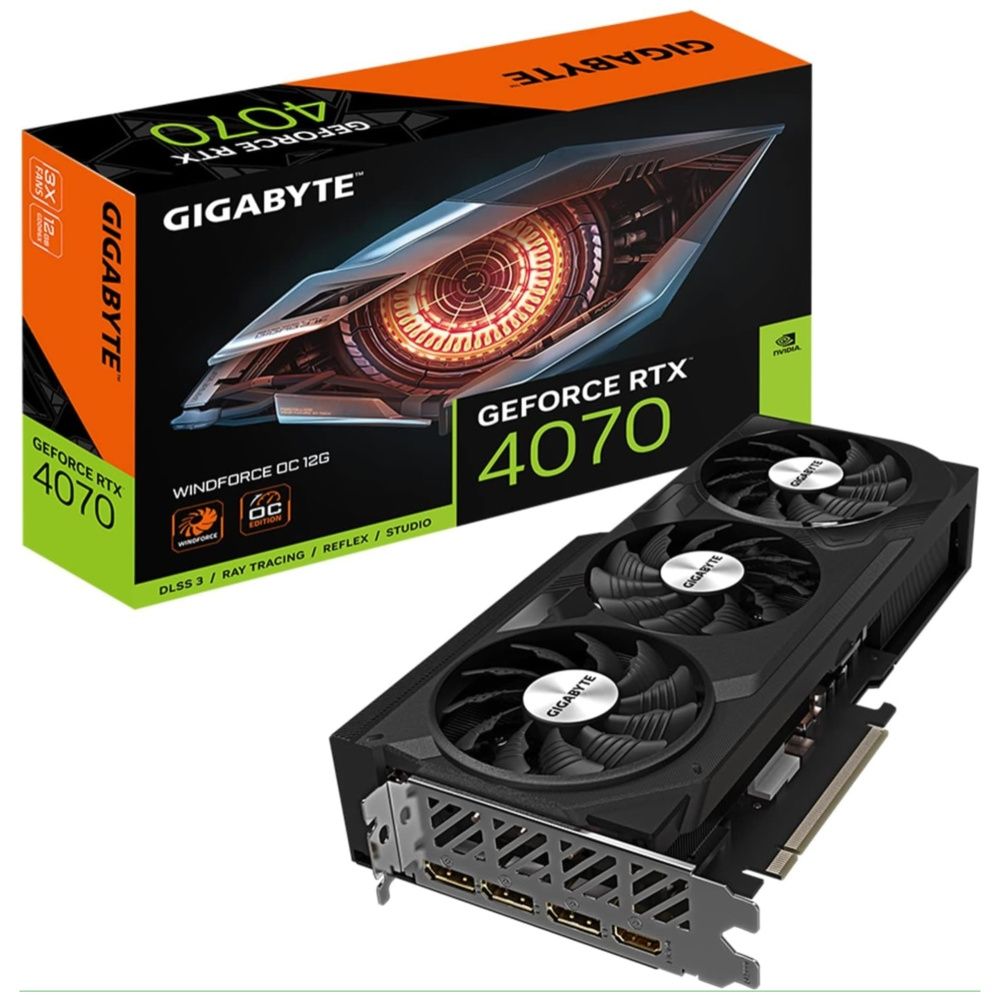
Gigabyte GeForce RTX 4070 WINDFORCE OC 12G
The Best Value Nvidia Graphics Card
Tri-Fan Budget Play
$550 $600 Save $50
The Gigabyte GeForce RTX 4070 WINDFORCE OC 12G is a powerful graphics card that can run most modern games comfortably at 1440p. It comes with a triple fan design for better heat dissipation. It boasts higher clock speeds than the Founders Edition card at 2490 MHz. It has the same 5888 Cuda cores and 12 GB GDDR6 VRAM on a 192-bit memory bus.
The Gigabyte GeForce RTX 4070 WINDFORCE OC 12G is powered by a single 8-pin connector and the company recommends a 650W PSU for this card.
- Brand
- Gigabyte
- Cooling Method
- Triple fan
- GPU Speed
- 1920 MHz
- Memory
- 12 GB GDDR6
- Power
- 650W PSU recommended
- CUDA Cores
- 5888
- Offers excellent rasterization performance vs the lower-end RTX 3070/4060TI, going neck and neck with an RTX 3080
- Offers significantly better RT and DLSS3 performance than its predecessors
- Comes factory overclocked out of the box unlike the similarly priced Founders Edition
- Doesn’t have the same performance gains as previous generations for the same price point
The tri-fan Gigabyte GeForce RTX 4070 WINDFORCE OC 12G is an impressive GPU on offer at a steep discount over MSRP with $50 off even below the Founder’s Edition while offering a mild overclock as part of its offering. What was expected to be an across-the-board cut on Nvidia RTX 4070s in response to AMD’s RX 7800XT seems to have been limited to a select few units and the Windforce OC is one of the better SKUs users can pick up even as it qualifies for Nvidia’s new Alan Wake 2 bundle.
With extensive cooling in play to ensure the RTX 4070 remains a cool customer while gaming or even while running benchmarks, the Windforce OC can be pushed higher manually with ease for more advanced users. It also has 2 BIOS updates since its release, both of which improve on its Fan Stop tech to tweak its curves and ensure the GPU only runs them when thermal requirements kick in.
All in all, the Gigabyte GeForce RTX 4070 WINDFORCE OC 12G is a solid entry for the mid-range Nvidia GPU’s lineup and its price tag makes it a considerably better-valued deal than most of its competition even as it retains prices post Prime Day sale offerings.
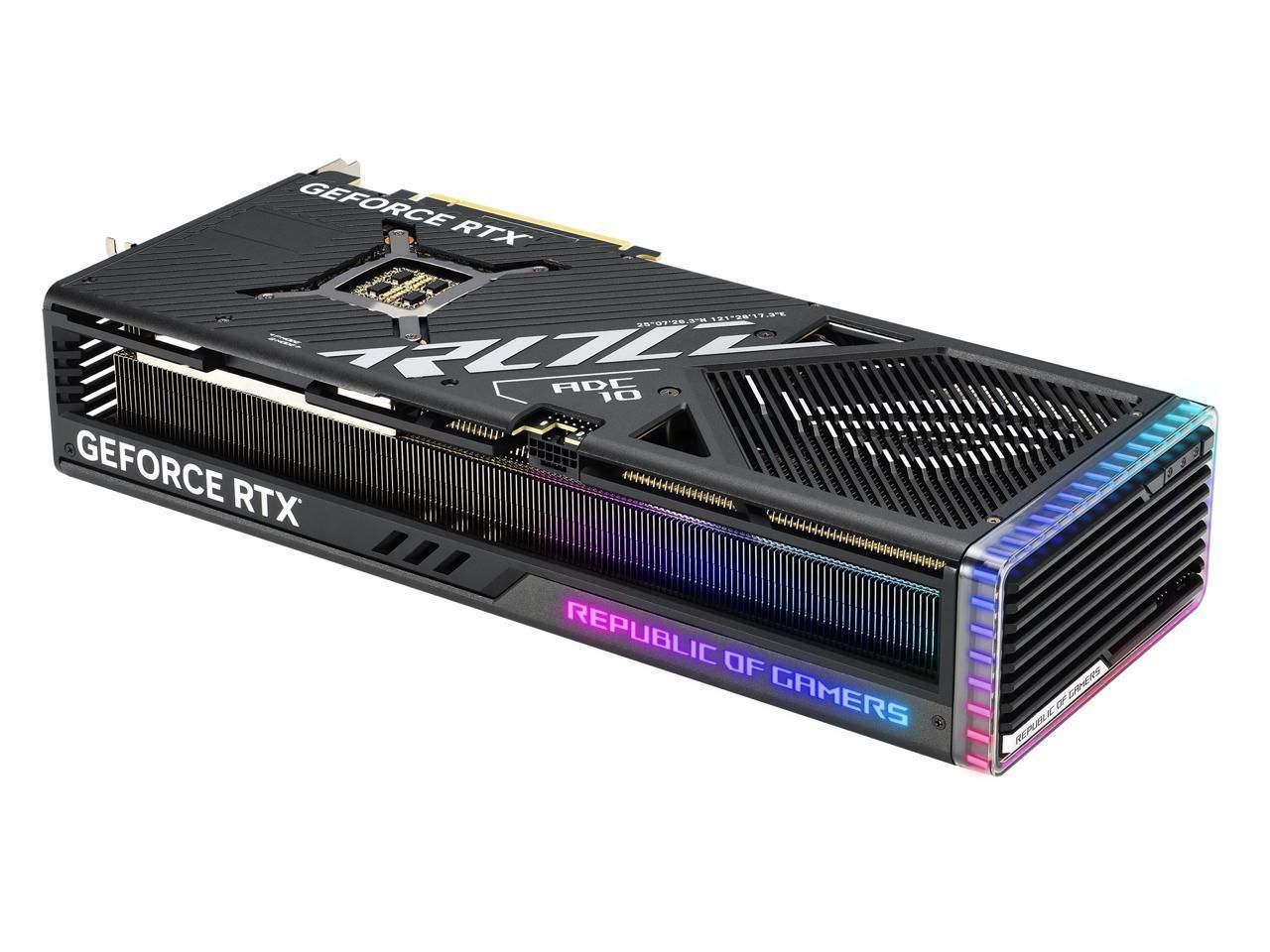
ASUS ROG Strix GeForce RTX 4090 OC Edition
The Best Performance Nvidia Graphics Card
The Fastest RTX 4090 Money Can Buy
The ASUS ROG Strix GeForce RTX 4090 OC Edition may be one of its largest GPUs ever, but the patented design supports the most potent overclocking potential out of its peers. With a vapor chamber in tow, the ROG Strix comes in both black and white and does not disappoint in either looks or power. It is easily the most powerful 4090 out there, clocking at a stable 3120 MHz in Game Rant’s tests.
- Brand
- Asus
- Cooling Method
- Air-Cooled w/Vapor Chamber
- GPU Speed
- 2640 Mhz
- Memory
- 24 GB GDDR6X
- Power
- 600W
- Boost Speed
- 2640 Mhz
- Interface
- PCI-E 4.0
- CUDA Cores
- 16384
- Is a performance-centric variant of the fastest GPU
- The only GPU on the market that allows for true 4K 120FPS gaming
- DLSS 3.0 ‘Framegen’ allows this GPU to push well above its native rasterization performance
- Sells at a relatively high premium compared to other RTX 4090 SKUs
- Has considerable power requirements compared to other variants
At least as far as gaming-oriented graphics cards go, the GeForce RTX 4090 is the most powerful option currently on the market. Besides generating some insane frame rates even at 4K resolutions, one of the most important additions is support for DLSS 3. DLSS is a feature that often causes confusion about what it does and how it benefits the typical gamer.
Essentially, DLSS boosts the frame rates of games by rendering frames at a lower resolution and then using AI to upscale these frames to a steadier higher resolution. Framegen builds onto this by creating AI-generated frames between two GPU-rendered frames to give a smoother experience to the end user and enable gaming smoother at higher resolutions with current-gen graphics cards or playing newer games with older GPUs.
While support for DLSS 3.0 is growing over time, gamers can immediately benefit from the incredible raw power of the Asus ROG Strix GeForce RTX 4090 OC Edition by pushing resolutions and frame rates that would not otherwise be possible. Playing games at 4K 120 fps is now a very real possibility with this graphics card, without compromising on lower texture or reflection settings. Although monitors and TVs to test games at 8K are scarce, early benchmarks have cards like the Asus ROG Strix GeForce RTX 4090 performing surprisingly well at this resolution.
Compared to the stock NVIDIA GeForce RTX 4090, Asus has made a massive piece of hardware that looks more like a box than a card. Performance compared to the Founders Edition is even better, with a maximum clock speed of 2640 MHz, and the Aura Sync RGB lighting effects are stunning. Buyers will need a beefy power supply to run the card, with an 850-watt PSU a safe bet. Measuring over 14 inches long, the Asus card will also be a challenge to put in many smaller PC cases. That being said, the Asus ROG Strix GeForce RTX 4090 OC Edition is the most performant variant of the fastest NVIDIA graphics card on the planet, and that alone makes it a solid contender for and the ultimate winner of Game Rant’s best-performance Nvidia GPU title.
The Asus Strix RTX 4090 OC is the fastest RTX 4090 to date available commercially unless one is counting the much harder-to-find ROG Matrix GeForce RTX 4090 Platinum that clocks in at a behemoth $3200 while being sold out at multiple retailers. It has seen a mild price uptick, primarily due to its limited availability with the white SKU of the same model going up in price considerably compared to the competition due to it being even more scarce in supply.
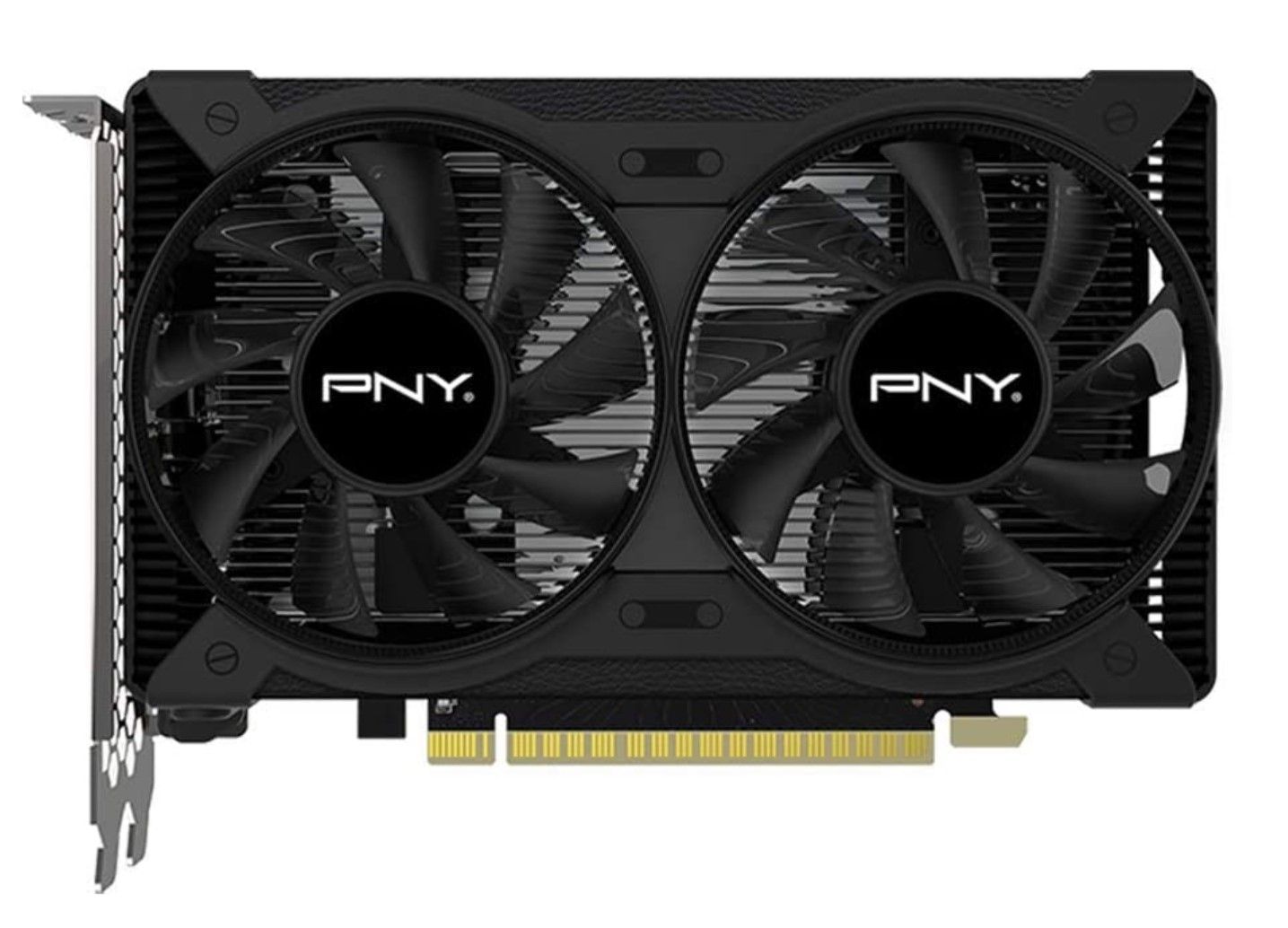
PNY GeForce GTX 1650 4GB GDDR6 Dual Fan Graphics Card
The Best Budget Nvidia Graphics Card
Low-Priced Entry-Level Graphics
$160 $190 Save $30
The PNY GeForce GTX 1650 is the ideal graphics card for gamers on a budget or building a compact power-efficient rig. This PNY graphics card maximizes the potential of the NVIDIA Turing architecture, with variable rate shading, mesh shading, and multi-view rendering. The PNY GeForce GTX 1650 requires a system running only a 300-watt or greater power supply.
- Brand
- PNY
- Cooling Method
- Air
- GPU Speed
- 1410 Mhz
- Interface
- PCI Express 3.0
- Memory
- 4 GB GDDR6
- Power
- 75 watts
- Boost Speed
- 1590 Mhz
- Does not require a discrete power connection
- Perfect for low-end PCs thanks to its low-profile design
- Good 1080p performance in esports titles
- Does not have RT or DLSS Support
- Does not have any RGB lighting
It’s easy to forget a time when graphics cards weren’t more expensive than a top-tier CPU or any other PC component. Today, gamers putting together a new rig often decide first on what NVIDIA or AMD graphics card they can afford and build the rest of a rig around that choice. Fortunately, some budget options are still available, at least for buyers not interested in gaming in higher than 1080p resolution. The PNY GeForce GTX 1650 doesn’t support any fancy features like ray-tracing or DLSS, but it’s a great option for a highly compact gaming PC or as a reliable graphics card for office work.
The PNY GeForce GTX 1650 isn’t much to look at, but its minimalist design allows it to fit into the tight chassis of mini ITX cases. Additionally, the graphics card does not require an additional power connector, simplifying the already difficult cable management in smaller systems. The total power usage of the card is a mere 75 watts. In the past, some stock GTX 1650 cards have lacked DisplayPort connections, but fortunately, the PNY GeForce GTX 1650 offers two of these ports along with one HDMI 2.0 connection.
PNY’s GeForce GTX 1650 is a perfectly acceptable card for running games at 1080p with high detail settings. 60 fps gaming is a sure bet, with the card adequate for 120 fps in some moderately demanding titles. For anything more than that, gamers will have to step up to a more expensive alternative like the RTX 3050. Nevertheless, the PNY GeForce GTX 1650 is one of the better NVIDIA graphics card options for budget shoppers.
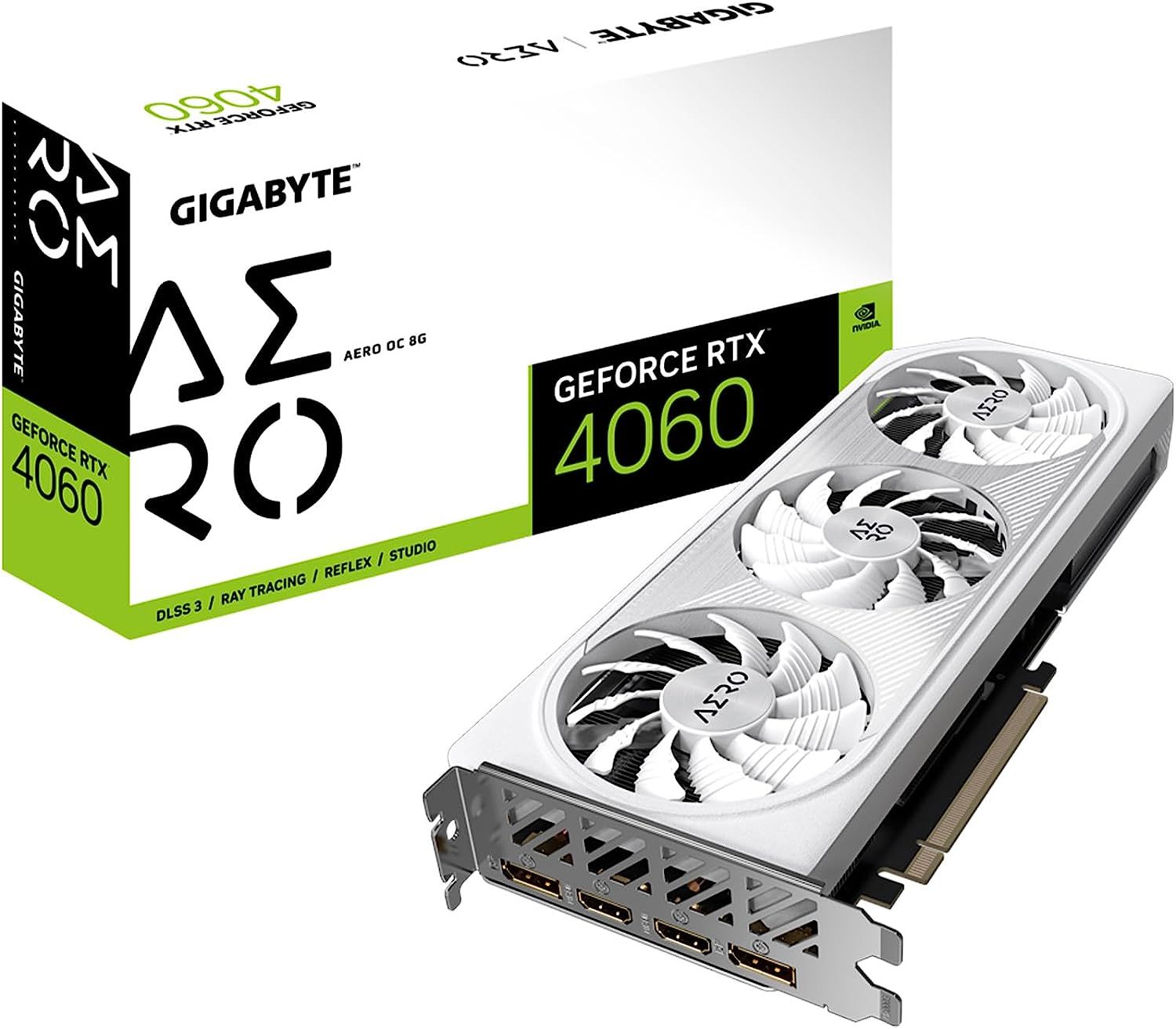
Gigabyte GeForce RTX 4060 AERO OC 8G
The Best Mid-Range NVIDIA Graphics Card
The Gigabyte GeForce RTX 4060 AERO OC 8G is the best-looking white-themed RTX 4060 SKU currently available on the market, offering decent boost clocks versus the stock option, a large, tri-fan air cooler that keeps temperatures low, and a stylish metal backplate design with ‘screen cooling’ that allows it to dissipate heat better. All of this is coupled with a dual-BIOS, dual-HDMI offering that gets the job done with style.
- Brand
- Gigabyte
- Cooling Method
- Tri-Fan Air Cooled
- GPU Speed
- 1830 MHz
- Interface
- PCI Express 4.0
- Memory
- 8GB GDDR6
- Power
- 115W
- Boost Speed
- 2550 MHz
- CUDA Cores
- 3072
- Offers an excellent tri-fan cooling solution
- Considerably more aesthetically pleasing than its competing RTX 4060 SKUs
- Is much more power efficient than its predecessor
- Offers dual bios in an entry-level GPU with Dual HDMI 2.1 ports for power users
- Leverages better DLSS3 performance to make for a more appealing option to its competition
- Offers 8GB of VRAM which is 4GB less than its predecessor
- Has similar performance in most rasterization tests to the much older RTX 3060
The Gigabyte GeForce RTX 4060 AERO OC 8G is an excellent mid-range GPU that offers the newer DLSS3-backed RTX 4000 series experience to gamers or enthusiasts on a budget while aiming to replace the well-received and considerably well-entrenched RTX 3060 GPU. It does so by targeting the sub-$300 market of GPUs and directly offering replacements that will over time phase out the aging RTX 3060 GPU while being readily available on shelves since launch, unlike some of the higher-end RTX 4090 GPUs.
The RTX 4060 GPU itself offers better efficiency than its predecessor, coupled with much better DLSS3 performance and faster clocks. It also cuts down on the VRAM on offer even as modern titles become more memory-hungry. Instead, it offers a singular 8GB model versus the more generous 12GB on the RTX 3060.
Gigabyte’s AERO OC take on the RTX 4060 sees it leverage one of the better aesthetic designs on the market by marrying its large tri-fan design with the all-white AERO concept. It makes for a beautiful yet cost-effective RTX 4060 SKU to consider at only a $30 premium over the founder’s edition while offering quiet operation.
With higher clocks and lower temperatures, the Gigabyte GeForce RTX 4060 AERO OC 8G is an easy recommendation for new gamers. For gamers coming from an RTX 3060 or equivalent, it might not be the generational GPU upgrade that one might assume it should be with similar rasterization performance under the hood, making it an unworthy upgrade, to say the least.
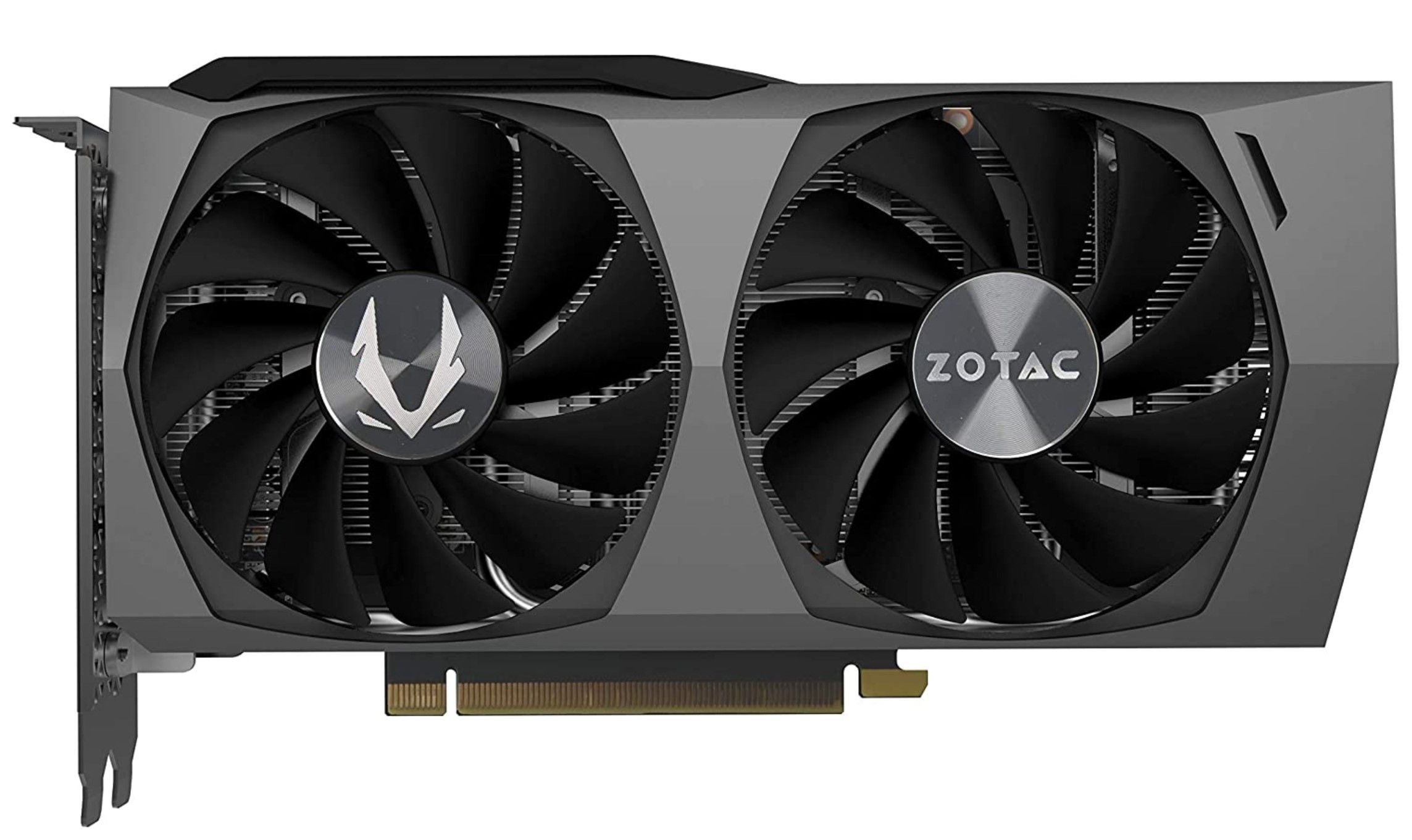
ZOTAC Gaming GeForce RTX 3060 Twin Edge OC
The Best Alternate Mid-Range NVIDIA Graphics Card
Decent Power Meets Plenty Of Memory
Maximizing the power of the NVIDIA Ampere architecture, the ZOTAC GeForce RTX 3060 Twin Edge OC has 12 GB of high-speed GDDR6 memory for blistering performance. Gamers on a modest budget can enjoy the latest NVIDIA features like 2nd Gen Ray Tracing with this ZOTAC graphics card. The ZOTAC Gaming GeForce RTX 3060 Twin Edge OC employs IceStorm 2.0 cooling for a wider cooling airflow. The card is constructed using a new more durable metal backplate, ensuring that it will last through years of grueling gaming sessions.
- Brand
- Zotac
- Cooling Method
- Air cooled
- Interface
- PCI Express 4.0
- Memory
- 12GB GDDR6
- Power
- 170 watts
- Boost Speed
- 1807 MHz
- Supports DLSS and Ray Tracing
- Minimal length ideal for compact PCs
- 12 GB of VRAM on offer
- Power connectors in an awkward location
- Somewhat disappointing 1440p performance
A mid-range graphics card today is a substantial investment, costing as much or more as some seriously powerful CPUs. However, the Zotac Gaming GeForce RTX 3060 Twin Edge OC allows gamers to enjoy the features of the NVIDIA Ampere architecture introduced in the 30 series, without the significant jump in price seen with the RTX 3070 and higher. The RTX 3060 graphics cards ship with 12 GB of DDR6 memory, which is actually more than the RTX 3060 Ti packs, albeit with a slower memory bus.
With the Zotac Gaming GeForce RTX 3060 Twin Edge OC, the clock speed of the stock RTX 3060 is boosted to 1807 MHz. To combat higher temperatures, Zotac uses its IceStorm 2.0 system, which takes advantage of new 11-blade fans for increased airflow and cooling coverage. The length of this card is worth noting since it measures under 9 inches. The Zotac Gaming GeForce RTX 3060 Twin Edge OC is almost as wide as it is long, but its shape allows compact PCs to experience some high-end gaming performance.
The Zotac Gaming GeForce RTX 3060 Twin Edge OC is among the best graphics cards for running games at 1080p resolutions. It should age better than older cards with newer and more demanding titles. 1440p is a riskier proposition with the Twin Edge OC, but its main advantage is its support for Ray Tracing and DLSS at lower resolutions. Three 1.4a DisplayPorts and one HDMI 2.1a connector will ensure that the card can connect to any modern monitor or TV. With superior 1080p performance, NVIDIA’s stable Ampere architecture, and a surprisingly compact shape, the Zotac Gaming GeForce RTX 3060 Twin Edge OC ranks among the best NVIDIA GPUs.
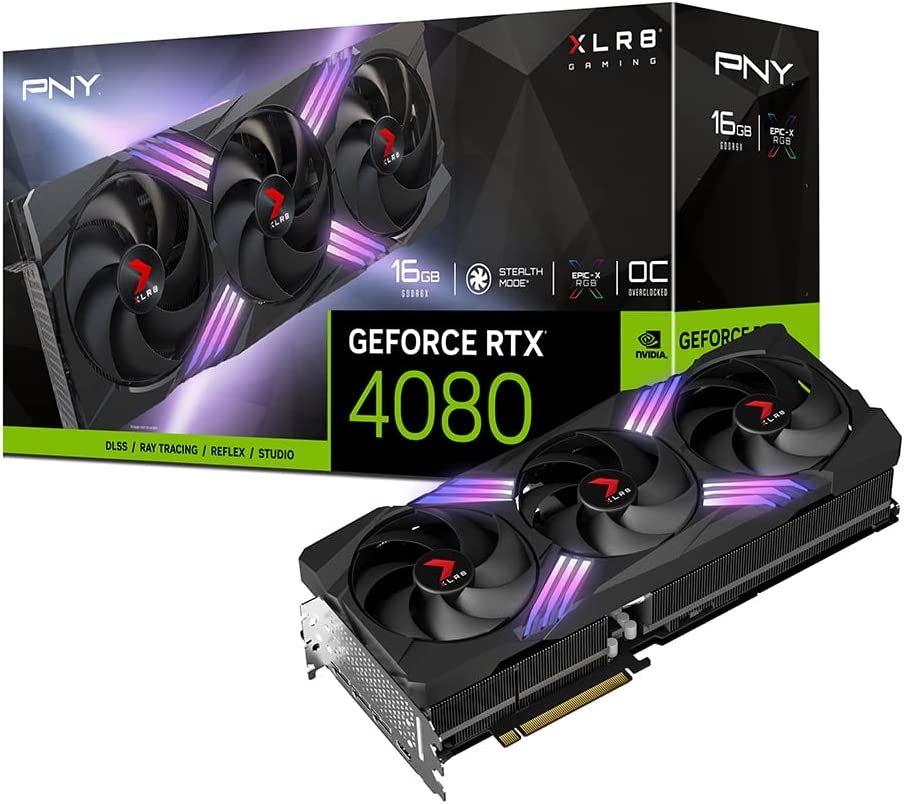
PNY GeForce RTX 4080 16GB XLR8 Gaming GPU
The Best High-End Nvidia Graphics Card
Powerful, Quiet, Adequate
$1140 $1200 Save $60
The PNY GeForce RTX 4080 16GB XLR8 Gaming OC GPU is an excellent RTX 4080 GPU that is priced at a discount compared to the bulk of its competition while offering decent performance in tow. It does have relatively tame boost clocks, however, while using a tri-fan air-cooled thermal component to keep temperatures in check.
- Brand
- PNY
- Cooling Method
- Tri-Fan Air Cooling
- GPU Speed
- 2205 MHz
- Interface
- PCI Express 4.0
- Memory
- 16GB GDDR6X
- Power
- 320 W
- Boost Speed
- 2550 MHz
- CUDA Cores
- 9728
- One of the best-looking RTX 4080 SKUs in the market; subtle lighting coupled with good aesthetics
- Has excellent cooling thanks to a quiet tri-fan air-cooled thermal solution on offer
- Excellent build quality compared to some of the competition
- One of the cheapest and yet well-balanced RTX 4080 SKUs we could find
- Has a relatively tame boost clock rating out of the box
The best high-end Nvidia graphics card on the list is surprisingly an RTX 4080. The PNY GeForce RTX 4080 16GB XLR8 Gaming GPU currently trades at a discount compared to most RTX 4080 SKUs as well as the Founder’s Edition. It offers a discount over its Founder’s Edition equivalent and tends to outperform somewhat thanks to better cooling, better clocks, aesthetics, and more.
While it isn’t the fastest RTX 4080 out there, it doesn’t need to be given its unique value proposition as both the cheapest RTX 4080 on the block and its mid-range performance tier within its own GPU class. With subtle lighting, solid build quality, and adequate RTX 4080-tier performance at a price point that doesn’t make the RTX 4080 feel like a bad tradeoff, it is Game Rant’s pick for the best high-end Nvidia Graphic Card one can currently buy.
If one plans to spend more or is looking for a more premium RTX 4080 SKU, they should consider looking at the now-cheaper RTX 4090 SKUs that are pushing downwards towards the sub-$1500 mark for a relative bargain instead.
The PNY GeForce RTX 4080 16GB XLR8 Gaming GPU now trades at a full $100 discount compared to Nvidia’s MSRP for the RTX 4080 Founder’s Edition, making it one of the cheapest RTX 4080 units on the market. With the added Overwatch 2 bundle for the RTX 4000 series GPUs, it is an even more appealing proposition than ever before for gamers looking for a true next-gen experience at a sub $1k price point.
FAQ
Q: What is the #1 GPU in the world?
In terms of gaming, NVIDIA’s GeForce RTX 4090 series of GPUs far outclass any of the competitors, including NVIDIA’s other offerings. But for the size of nearly an Xbox Series S, it’s no wonder this graphics card can output FPS like no other.
Q: What is the best graphics card for 4K gaming?
The RTX 4080 or higher is the ideal GPU for 4K gaming. It can sustain 4K games at high frame rates thanks to DLSS 3. However, the RTX 3080 and RTX 3090 also provide stable 60 fps frame rates at 4K resolutions for many games.
Q: What is the difference between NVIDIA GTX and RTX graphics cards?
NVIDIA’s RTX graphics cards provide ray-tracing support and tend to have higher amounts of VRAM, CUDA Cores, and GPU speeds than their older GTX series. In fact, besides the GTX 1650, the rest of the line has halted production in favor of the RTX series. This isn’t to say this card isn’t viable any longer, but as the VRAM capacity for GPUs increases over the years, 4GB is no longer cutting it.
Source link